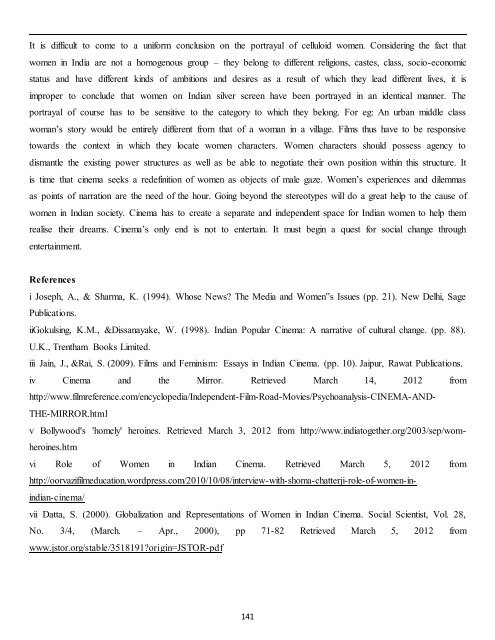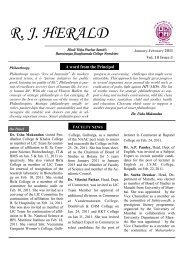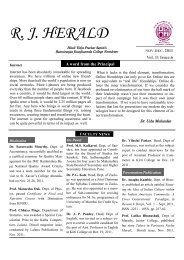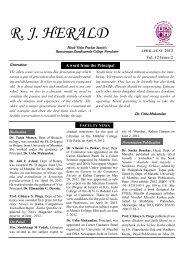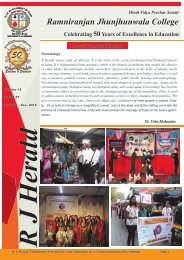ISBN 978-81-925489-2-0 - ramniranjan jhunjhunwala college
ISBN 978-81-925489-2-0 - ramniranjan jhunjhunwala college
ISBN 978-81-925489-2-0 - ramniranjan jhunjhunwala college
Create successful ePaper yourself
Turn your PDF publications into a flip-book with our unique Google optimized e-Paper software.
It is difficult to come to a uniform conclusion on the portrayal of celluloid women. Considering the fact that<br />
women in India are not a homogenous group – they belong to different religions, castes, class, socio-economic<br />
status and have different kinds of ambitions and desires as a result of which they lead different lives, it is<br />
improper to conclude that women on Indian silver screen have been portrayed in an identical manner. The<br />
portrayal of course has to be sensitive to the category to which they belong. For eg: An urban middle class<br />
woman’s story would be entirely different from that of a woman in a village. Films thus have to be responsive<br />
towards the context in which they locate women characters. Women characters should possess agency to<br />
dismantle the existing power structures as well as be able to negotiate their own position within this structure. It<br />
is time that cinema seeks a redefinition of women as objects of male gaze. Women’s experiences and dilemmas<br />
as points of narration are the need of the hour. Going beyond the stereotypes will do a great help to the cause of<br />
women in Indian society. Cinema has to create a separate and independent space for Indian women to help them<br />
realise their dreams. Cinema’s only end is not to entertain. It must begin a quest for social change through<br />
entertainment.<br />
References<br />
i Joseph, A., & Sharma, K. (1994). Whose News? The Media and Women‟s Issues (pp. 21). New Delhi, Sage<br />
Publications.<br />
iiGokulsing, K.M., &Dissanayake, W. (1998). Indian Popular Cinema: A narrative of cultural change. (pp. 88).<br />
U.K., Trentham Books Limited.<br />
iii Jain, J., &Rai, S. (2009). Films and Feminism: Essays in Indian Cinema. (pp. 10). Jaipur, Rawat Publications.<br />
iv Cinema and the Mirror. Retrieved March 14, 2012 from<br />
http://www.filmreference.com/encyclopedia/Independent-Film-Road-Movies/Psychoanalysis-CINEMA-AND-<br />
THE-MIRROR.html<br />
v Bollywood's 'homely' heroines. Retrieved March 3, 2012 from http://www.indiatogether.org/2003/sep/womheroines.htm<br />
vi Role of Women in Indian Cinema. Retrieved March 5, 2012 from<br />
http://oorvazifilmeducation.wordpress.com/2010/10/08/interview-with-shoma-chatterji-role-of-women-inindian-cinema/<br />
vii Datta, S. (2000). Globalization and Representations of Women in Indian Cinema. Social Scientist, Vol. 28,<br />
No. 3/4, (March. – Apr., 2000), pp 71-82 Retrieved March 5, 2012 from<br />
www.jstor.org/stable/351<strong>81</strong>91?origin=JSTOR-pdf<br />
141


